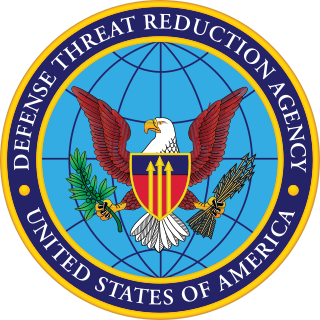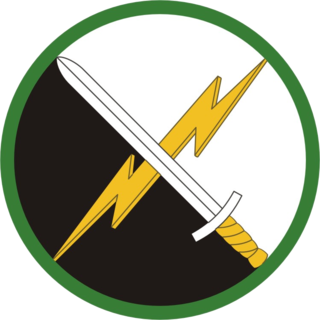Related Research Articles

The United States Space Command is a unified combatant command of the United States Department of Defense, responsible for military operations in outer space, specifically all operations 100 kilometers and greater above mean sea level. U.S. Space Command is responsible for the operational employment of space forces that are provided by the uniformed services of the Department of Defense.

The United States Strategic Command (USSTRATCOM) is one of the eleven unified combatant commands in the United States Department of Defense. Headquartered at Offutt Air Force Base, Nebraska, USSTRATCOM is responsible for strategic nuclear deterrence, global strike, and operating the Defense Department's Global Information Grid. It also provides a host of capabilities to support the other combatant commands, including integrated missile defense; and global command, control, communications, computers, intelligence, surveillance, and reconnaissance (C4ISR). This command exists to give "national leadership a unified resource for greater understanding of specific threats around the world and the means to respond to those threats rapidly".

The Defense Threat Reduction Agency (DTRA) is both a defense agency and a combat support agency within the United States Department of Defense (DoD) for countering weapons of mass destruction and supporting the nuclear enterprise. Its stated mission is to provide "cross-cutting solutions to enable the Department of Defense, the United States Government, and international partners to Deter strategic attack against the United States and its allies; Prevent, reduce, and counter WMD and emerging threats; and Prevail against WMD-armed adversaries in crisis and conflict." DTRA is headquartered in Fort Belvoir, Virginia. The DTRA mission, organization and management, responsibilities and functions, relationships, authorities, and administration are defined in DoD Directive 5105.62, Defense Threat Reduction Agency (DTRA) .

The Military Staff of the European Union (EUMS) is the directorate-general of the European Union's (EU) External Action Service (EEAS) that contributes to the EU's Common Security and Defence Policy (CSDP) by providing strategic advice to the High Representative (HR/VP) and commanding operations through its Military Planning and Conduct Capability (MPCC) operational headquarters. From the end of 2020, the MPCC will be capable of running executive operations of up to 2,500 troops, i.e. the size of one EU battle group, as well as 3 non-executive missions.

NetOps is defined as the operational framework consisting of three essential tasks, Situational Awareness (SA), and Command & Control (C2) that the Commander (CDR) of US Strategic Command (USSTRATCOM), in coordination with DoD and Global NetOps Community, employs to operate, manage and defend the Global Information Grid (GIG) to ensure information superiority for the United States.
Joint Task Force-Global Network Operations (JTF-GNO) was a subordinate command of United States Strategic Command whose mission was to: direct the operation and defense of the Global Information Grid (GIG) across strategic, operational, and tactical boundaries in support of the US Department of Defense's full spectrum of war fighting, intelligence, and business operations.

Joint Functional Component Command for Integrated Missile Defense is a component of United States Space Command (USSPACECOM). The current commander is Army Lieutenant General Daniel L. Karbler.
The Joint Functional Component Command for Intelligence, Surveillance and Reconnaissance was a subordinate command of the United States Strategic Command, one of the nine Unified Combatant Commands under the United States Department of Defense (DOD) and co-located with the Defense Intelligence Agency (DIA). It served as the center for planning, execution, and assessment of the United States military's global Intelligence, Surveillance, and Reconnaissance operations from 2005-2016; a key enabler in achieving global situational awareness. In 2016 JFCC-ISR was realigned to the Joint Staff.
The Quadrennial Defense Review (QDR) was a study by the United States Department of Defense that analyzes strategic objectives and potential military threats. The Quadrennial Defense Review Report was the main public document describing the United States' military doctrine. In 2018, the QDR was replaced by the National Defense Strategy.
The Joint Information Operations Warfare Center (JIOWC) was created by the U.S. Strategic Command (USSTRATCOM) sometime around 2004 or 2005 at Lackland Air Force Base, Texas, with the intent of coordinating and executing U.S. information operations at the strategic level. On September 12, 2011, by executive order, the JIOWC was chartered as a Chairman's Controlled Activity aligned under the Joint Staff. The JIOWC falls within the Joint Staff Operations Directorate (J3), through the Deputy Director Global Operations, J39 (DDGO).

Joint Task Force-Bravo is a forward-based expeditionary joint task force operating as U.S. Southern Command's (USSOUTHCOM) lead forward element in the Central America (CENTAM) region to promote stability and security and counter transnational and transregional threat networks (C-T3N). JTF-Bravo operates out of Soto Cano Air Base, Honduras, located 10 miles south of the city of Comayagua and 50 miles north of the capital city of Tegucigalpa.

The 1st Information Operations Command (Land), formerly the Land Information Warfare Activity Information Dominance Center (LIWA/IDC), is an information operations unit under the operational control of U.S. Army Cyber Command (ARCYBER) and headquartered at Fort Belvoir, Virginia.

The Vice Chief of the Defence Force (VCDF) is the military deputy to the Chief of the Defence Force (CDF) of Australia, and acts as the CDF in his absence under standing acting arrangements. Vice Admiral David Johnston, the incumbent VCDF, has held the position since 5 July 2018.

The 20th CBRNE Command is the United States Army headquarters for defense against Chemical, Biological, Radiological, Nuclear, and high-yield Explosives (CBRNE), headquartered on the site of the defunct Edgewood Arsenal chemical weapons production facility at Aberdeen Proving Ground in northern Maryland.

The European Union Operations Centre was an ad-hoc, non-standing, non-commanding headquarters facilitating the planning and conduct of military operations deployed as part of the European Union's (EU) Common Security and Defence Policy (CFSP) that was active between 2012 and 2016.

The Fleet Electronic Warfare Center (FEWC) is a subordinate organization of the Naval Network Warfare Command (NNWC), which was established in 2008 to be the center for US Navy fleet electronic warfare (EW) operational and tactical issues. It is currently located at Navy Information Dominance Forces (NIDF) Headquarters, in Suffolk, VA as an independent directorate.
Elimination is one of the eight Weapons of Mass Destruction (WMD) mission areas as outlined by the United States Department of Defense in the 2006 National Military Strategy to Combat WMD and Joint Publication 3-40. "Elimination" is a mission under the Counterproliferation pillar (goal).
A Joint Task Force for Elimination (JTF-E) headquarters was a concept for a military task force headquarters staffed by joint personnel for the purpose of conducting WMD Elimination operations through command and control of joint elimination enablers such as nuclear disablement teams, CBRN Response Teams, radiation assessment teams, and medical laboratories. A JTF-E headquarters may be formed per Joint Publication 3-40 one of two ways: 1) An existing headquarters designated by a Combatant Commander with Joint Elimination Coordination Element (JECE) augmentation and 2) Joint Forces Command (JFCOM) establishing a JTF-E by utilizing the JECE and another existing headquarters.
Joint Functional Component Command for Space and Global Strike was a component of the United States Strategic Command. It was headquartered at Offutt Air Force Base, Nebraska. The Commander, JFCC SGS was dual hatted as the Commander, Eighth Air Force and Commander, JFCC SGS. On 19 July 2006, JFCC SGS was reorganized into two separate JFCCs: Joint Functional Component Command for Global Strike and Integration and Joint Functional Component Command for Space.
Army Service Component Commands (ASCCs) are U.S. Army commands responsible for recommendations to the Joint Force Commander on the allocation and employment of U.S. Army forces within a unified combatant command (CCMD) or further assigned to a subordinate unified command.
References
- ↑ "Reference at www.stratcom.mil".
- ↑ "U.S. Strategic Command".
- ↑ Quadrennial Defense Review Report (PDF) (Report). Office of the US Secretary of Defense. 6 February 2006. Archived from the original on 2012-10-28 – via Internet Archive.
- ↑ "Reference at www.defense.gov" (PDF).